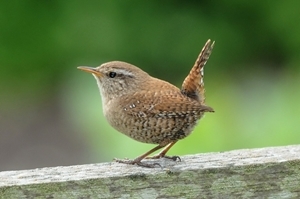Wren (Troglodytes troglodytes)
 Troglodytes means cave dweller and was probably given to the wren because of its habit of exploring any available hole, nook or cranny in its hunt for insects. The word wren comes from the Middle English word wrenne meaning little tail.
Troglodytes means cave dweller and was probably given to the wren because of its habit of exploring any available hole, nook or cranny in its hunt for insects. The word wren comes from the Middle English word wrenne meaning little tail.
Many refer to the bird by giving it a feminine gender, calling it Jenny Wren and remarking on how sweetly “she” sings. Charles Dickens chose the name of Jennie Wren for the little disabled doll’s dressmaker in his book Our Mutual Friend (1864-5), while Paul McCartney wrote a pop song entitled Jenny Wren (2005), all helping to keep the name in everyday use.
The wren is at present our most common breeding bird, with around 8.5 million pairs. I say at present, because it only needs a long hard winter, such as we experienced in 1962/3 to knock the little bird off the top spot. Being totally reliant on insects can be a real problem when prolonged cold, snowy weather reduces numbers dramatically.
One good tactic they have developed, though, to help get through long cold winter nights is to collect together to roost. A good idea when you only weigh the same as a £1 coin. (By the way, the collective name for a group of wrens is a herd!) An unbelievable 60 individuals were counted going into a single bird box, all huddling together for warmth, with the final bird’s tail still sticking out of the hole due to lack of space! Often they will use roof spaces in houses to communally roost, with to my knowledge 96 being the record here – unless you can tell me otherwise!!
In the spring, the male is incredibly busy as he will construct up to six domed nests dotted around the territory, leaving the female to choose her favourite, which she then lines with hair and feathers, before laying up to 8 white eggs that are finely speckled with reddish spots. Because wrens are nearly always double brooded, they can quickly restore their population after a severe winter.
Wrens tend to be quite sedentary, not moving far from where they were born. However some will wander or migrate over surprisingly long distances. A nestling ringed in Germany during the summer of 1983 was found dead five months later in Cornwall. While another bird caught and ringed in Kent, went in the opposite direction, being re-trapped by a ringer the following year in Sweden, having travelled a distance of 728 miles in only 6 months!
The diminutive wren does have another grand title to go alongside its impressive scientific name, that of King of the Birds. The legend goes that all the birds of the world decided that one bird should be made king and that the honour would be bestowed on the bird which could soar to the greatest height. The little wren quickly realised that the eagle would undoubtedly win the competition, so she snuck onto the back of the eagle, ensuring that in fact the wren had reached the highest point, not the eagle!
Despite all of these amazing snippets concerning wrens, my favourite thing about them is that, for their size they have the most incredibly powerful song, which literally bursts out of the little vibrating performer as it sits on top of some vantage point. What is more, you can hear this joyful song at any time of the year. I am always rather humbled, when on a freezing cold winter’s day, as all sound is dulled by the snow lying on the ground, up will pop little Jenny Wren and loudly announce that she is still in the land of the living! Just incredible... coming from a bird that is so small. And talking of small things, how apt that the bird chosen to grace one of our smallest ever units of currency was none other than the wren, stamped for posterity on the reverse side of the tiny farthing coin!
Peter Thompson
Advisory
Read more from Peter Thompson at the Fresh from the Field blog.

Download Peter Thompson's essential 26-page book, featuring beautiful photography and detailed profiles of Britain's wildlife
Download FREE >